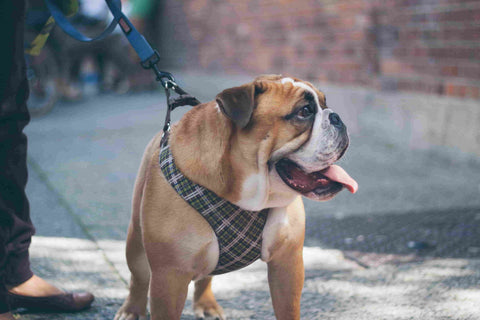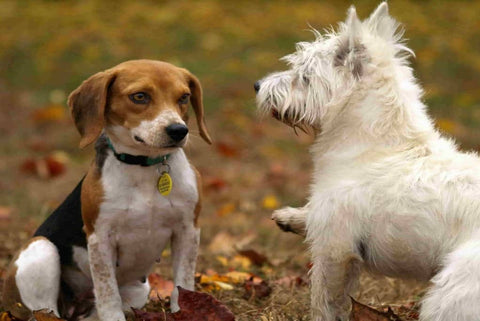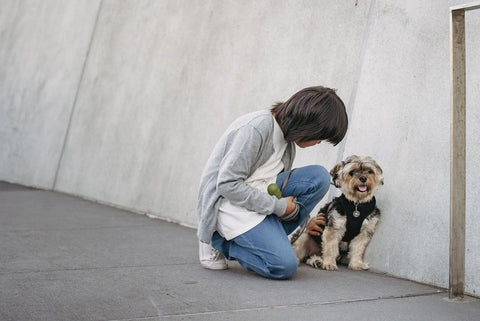Types of Dog Harnesses: How to Get the Right One
You love walking with your dog and even hiking and exploring the outdoors together, but your old collar and leash aren’t cutting it anymore. If that sounds like you, or perhaps you’re ready to outfit your brand new puppy to take into the world, we can help you.
First things first — rather than going with the old standard, which is a collar, why not try a harness?
We love harnesses because they’re safe and comfy for you and your dog. There are options that are versatile enough for walking, hiking, running and even training. You’re giving your dog a great experience and you’re also going to feel peace of mind.
With that in mind, you might be wondering how to choose the best dog harness when there are so many options out there. That’s where we come in. We can guide you through the entire process from start to finish. Learn more about the types of harnesses, how to get that just-right fit, and everything else you should know before you head out into the world with your four-legged best friend.
Types of Harnesses for Dogs
While the general concept is similar across the board, many of our customers are surprised to learn there are different types of dog harnesses, and some may be better suited to your needs than others. The primary differences are in the designs and clip placement, so these are what we’ll focus on.
Harness Designs
First, there are a few primary types of harness designs. To figure out which is going to suit your needs and the needs of your dog, you’ll want to compare each and see how they’re distinctive from one another and then consider how you’ll be using it.
Step-In Dog Harness
A step-in dog harness is a little different from what might come to mind when you think about a traditional harness. Instead of forming rectangles at your dog’s legs like a standard design does, this type of harness forms triangles.
You’d ideally have your dog stand over the harness while it’s on the ground, and then you buckle it from there.
Some dogs don’t like having things put over their heads, which is when you might consider this design. A step-in harness also alleviates pressure around the neck, and there are usually quick-releases fasteners.
If it’s challenging to fit your dog in other types of harnesses, this could be another time you’d consider a step-in design.
Back-Clip Harness
The clip of a harness is what the leash attaches to, but you may be surprised to learn it’s more than that. The location of the clip actually impacts how you use your harness.
With a back-clip harness, the D-ring attaching to the leash is located at the top. Having a back-clip leash gives you more control, and you can avoid tangling since the leash is away from your dog’s legs. The clip is also farther away from the neck, which is good from a safety perspective.
The downside of a back-clip harness is that if your dog pulls, this type of attachment can make the problem worse. A dog moves in the opposite direction from there’s force being applied. If your leash is pulling at the top, then a dog is pulling forward.
A back-clip harness is best for a dog that doesn’t pull and is fairly well trained. Otherwise, you may be reinforcing bad habits.
Front-Clip Dog Harness
Another option is the front-clip harness. The D-ring is at the chest. When a dog isn’t well-trained yet or pulls, a front clip is ideal. When your dog is pulling forward, they’ll feel front pressure. Since your dog’s natural tendency is to work against that pressure or oppose it, the front clip will encourage them to slow down.
The downside of a front clip is that it can cause chafing, but if you get the right fit, you can avoid this issue.
Dual-Clip Dog Harness
A dual-clip harness has a D-ring attachment at the back and front. This makes it a good dog harness for walking, hiking, running and training because you have versatility. You can even hook to both clips at once if you have a two-ended leash.
Athletic Harnesses
There’s sometimes the misconception that a collar is best for doing activities with your dog. This isn’t the case. A collar can be dangerous, offers minimal control, and isn’t versatile. A harness eliminates all of these issues.
A dog harness can be used for a variety of activities seamlessly, including:
- Dog harness for walking: When you use a dog harness for walking, you have a sense of control that you don’t get from a collar, but your dog is also safer and more comfortable. A harness is lightweight and is going to feel comfortable on your dog, rather than putting a lot of pressure on his neck as a collar would. With a dual-clip harness, you can switch your leash attachment if you’re in a crowded place and then move to somewhere more isolated. For example, a dog harness for walking means you can use it in an urban area, a park or an open area.
- Dog Harness for Hiking: When you’re hiking, you might hit the trails for hours at a time, meaning comfort is a priority. Choosing a dog harness for hiking means you should look for breathability and a lightweight design that gives your dog plenty of range of motion to deal with changes in terrain and elevation.
- Dog Harness for Running: Choosing a dog harness for running is similar to choosing one for hiking because lightweight breathability is important. Your dog is probably going to sweat when you’re on a run, so choose a material that’ll feel soft against their skin and reduce the potential for chafing. As a side note, a retractable leash pairs perfectly with a dog harness for running because you can hit the pavement without worrying about your dog getting tangled.
- Dog Harness for Training: For training, a harness is one of the best tools you can invest in. Harnesses evenly distribute the weight across a dog’s chest, and you can help teach him not to pull on your walks without pain or the risk of injury.
Getting the Proper Fit
While above, we’ve highlighted the many benefits of different types of dog harnesses, without the right fit, you’re not going to be able to take advantage of these.
Follow the steps below to get the proper fit, whether you’re looking for a dog harness for walking, a dog harness for training or a dog harness for running.
Step 1: Get Your Dog’s Weight
We’re going to include your dog’s weight as one of many factors that you should use to get the perfect fit on a harness, but we want to emphasize it’s not the only one. A big mistake we see is that people will only go by their dog’s weight, and that doesn’t give them the perfect fit.
Weight is just a starting point to guide the rest of your measurement. For example, a bulldog that weighs 30 pounds is going to have different needs in a harness than a lab that weighs the same. Dogs all have a unique build which is why you need to measure before you choose a harness.
Once you get the weight of your dog, get a tape measure, and let’s get started with the rest of the measurements.
Step 2: Measure the Neck Base
Using your tape measure, you should wrap it around the widest, thickest part of your dog’s neck. Don’t choose the point where a collar sits, which is narrower. Instead, aim to measure right at the top of the shoulders because a harness will sit at this point.
Step 3: Get a Girth Measurement
Girth is the width of the area behind your dog’s front legs, at the widest point. Wrap the tape measure around this area, which you can also think of as his armpits.
Step 4: Body Length
Another important measurement to ensure the perfect harness fit for your dog is body length. Using your tape measure, start at the point right behind your dog’s front legs. Bring it in a straight line to the point just behind the rear legs.
Step 5: Use the Pet&Cuddle Size Chart
Once you’ve gathered your measurements, head on over to the Pet&Cuddle website and check our size chart for harnesses. If your dog seems to be on the border between two sizes, go up in size.
Step 6: Try It Out and Check the Fit
Finally, once your new dog harness arrives, give it a test drive. Put it on your dog and adjust the straps. With the perfect fit, you should be able to put any two fingers between the straps and your dog’s fur or skin. It should feel snug but not too tight.
Another fit test is to try and slip the harness over your dog’s head. If you can, you need to either check the size or make other adjustments.
Features To Look For In a Good Harness
Is size the only thing to think about when you’re shopping for a dog harness? Not exactly.
There are some other factors you can use in comparison shopping too. Pay attention to:
- Safety: What’ll you find out once you start using a harness, especially if you’ve been using a collar, is that your dog will be safer. A good harness is one that’s comfortable and doesn’t put pressure at the neck. It reduces the risk of injury and choking.
- Easy to use: When you’re adding something to your daily routine, of course, you want it to be user-friendly. Your dog’s harness should be one that you can easily put on and take off without a lot of fuss.
- Adjustability: Adjustable straps will help get that fit just right on your dog.
- Weight: Choose a durable but lightweight design that you can grab on the go or throw into your back without a second thought.
- Clip Location: We like to emphasize to our customers how important clip location is. Our top pick? We prefer a dual-clip harness because you get the best of all worlds.
- Reflective details: Do you like to walk at night to unwind after work or maybe in the mornings before you start your day? If so, reflective details on a harness will keep you and your dog safe.
- Material: Pet&Cuddle always uses comfortable materials that are strong and durable but feel good on your dog’s body.
Can I Use a Dog Harness and Retractable Leash Together?
Probably one of the most frequent questions we get is whether or not it’s safe to use a dog harness and a retractable leash at the same time. Our answer is yes, and it’s even preferable, with a few things in mind.
First, try to use a retractable leash with a back-clip harness. A back-clip harness won’t put any uncomfortable pressure on your dog, even if they’re pulling. You still get more leverage than you would using a collar though, because you have a control point that’s located near your dog’s center of gravity.
Avoid using a retractable leash with a front-clip harness. That makes it uncomfortable and confusing for your dog. When your dog’s on a retractable leash attached to a front clip, it pinches their shoulders. If you do use a retractable leash and harness together, give the leash a little extra slack.
How Important Is it to Get the Right Type of Harness?
It takes a few minutes to familiarize yourself with the types of harnesses and to measure your dog, but it’s time well-spent. You’re going to give your dog a pleasant, comfortable, and above all, safe walking experience.
Whether you’re walking, running or hiking, it’s also going to be good for you because you’ll have control over your dog’s movements, but he can still maintain a sense of freedom to explore the world around him.
We, the Pet&Cuddle dog lovers, have created various types of harnesses for your dogs, which are safe yet can be used for training, leading, or adapting your pet for walking with a leash.
Discover the best dog harnesses we created exactly for your dog here.
Questions About Dog Harnesses
If you still have questions, check out the list we compiled below, which are common ones from our customers.
Are Harnesses More Secure For Dogs?
Think about how a harness fits and goes on. It doesn’t put all the pressure at one place on your dog’s neck, lowering the possibility of an injury. It’s more secure and gives you more control, too, assuming you get the right fit.
Do Harnesses Encourage Pulling?
It’s a myth that a harness would lead to pulling. Harnesses are a preferred training tool by professionals because they teach them not to pull with gentle force. If you do use a harness and you notice your dog’s pulling, there are two scenarios that could be happening.
The first is that your dog is still getting used to it. The second is that you’ve gotten the wrong size and it doesn’t fit well. If so, get in touch with our team, and we can help you find the right size.
Can You Keep a Harness on a Dog All Day?
There’s no benefit to keeping your dog’s harness on all day. It’s a training, walking, and athletic tool. Leaving a harness on all day could cause chaffing, circulation problems, or irritation.
Instead, take it off when you get home. Try to leave it in the same place every time and then your dog will know when you get it out, it’s time to go on an adventure.
What is the Best Dog Harness?
In our opinion, the best dog harness is one that fits well, is comfortable, and is safe. Whether you’re looking for a no-choke dog harness or a dog harness for summer, fit, comfort and safety are your biggest priorities. When you take measurements and choose a reputable company like Pet&Cuddle, you know you’re going to get the best dog harness.
Get Your Best Dog Harness on Pet&Cuddle
Okay, we’ve covered a lot of information but now you know why harnesses are better than collars, how to choose the right fit, and how to use them safely so you can make the most of their benefits. Are you ready to buy? If so, grab some measurements and head over to Pet&Cuddle.
We, the Pet&Cuddle dog lovers, are constantly creating new dog harness collections, which are safe, multifunctional, and effective for training, leading, or adapting purposes.
Discover the latest dog harness collection we created exactly for your dog here!




